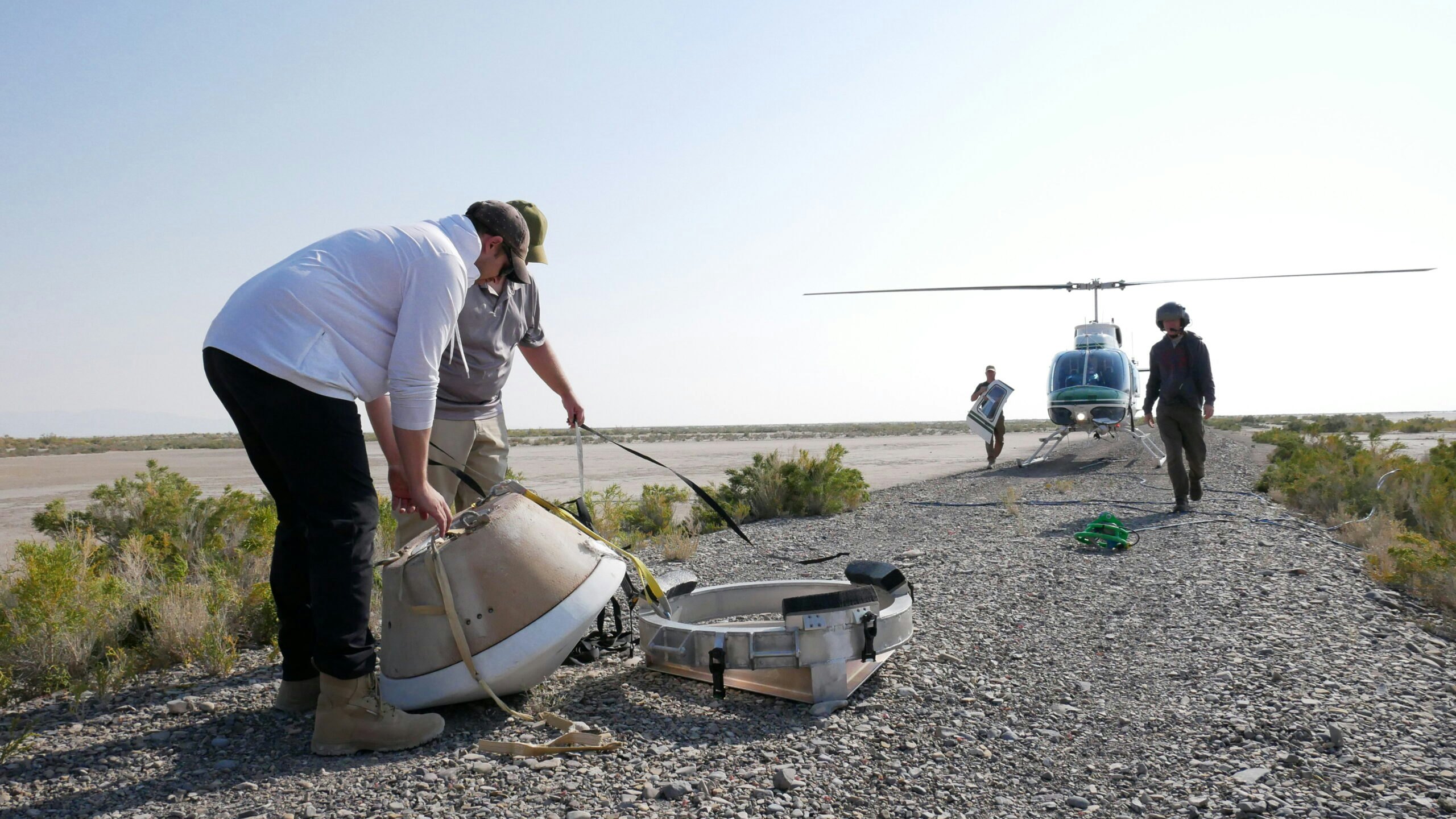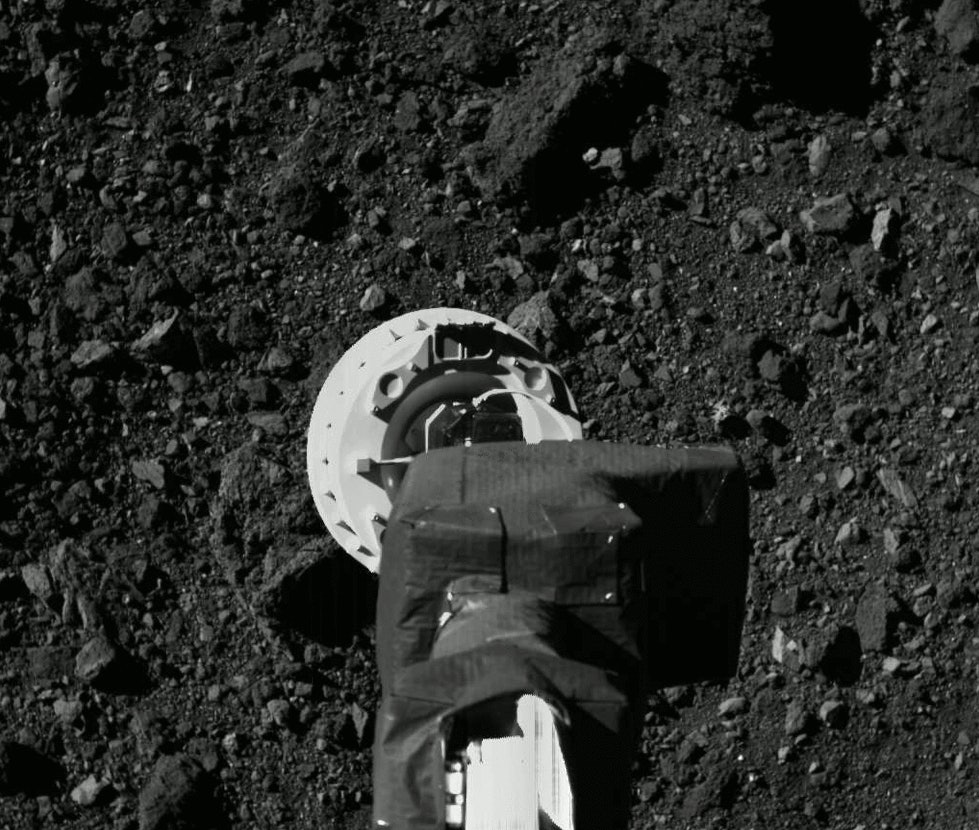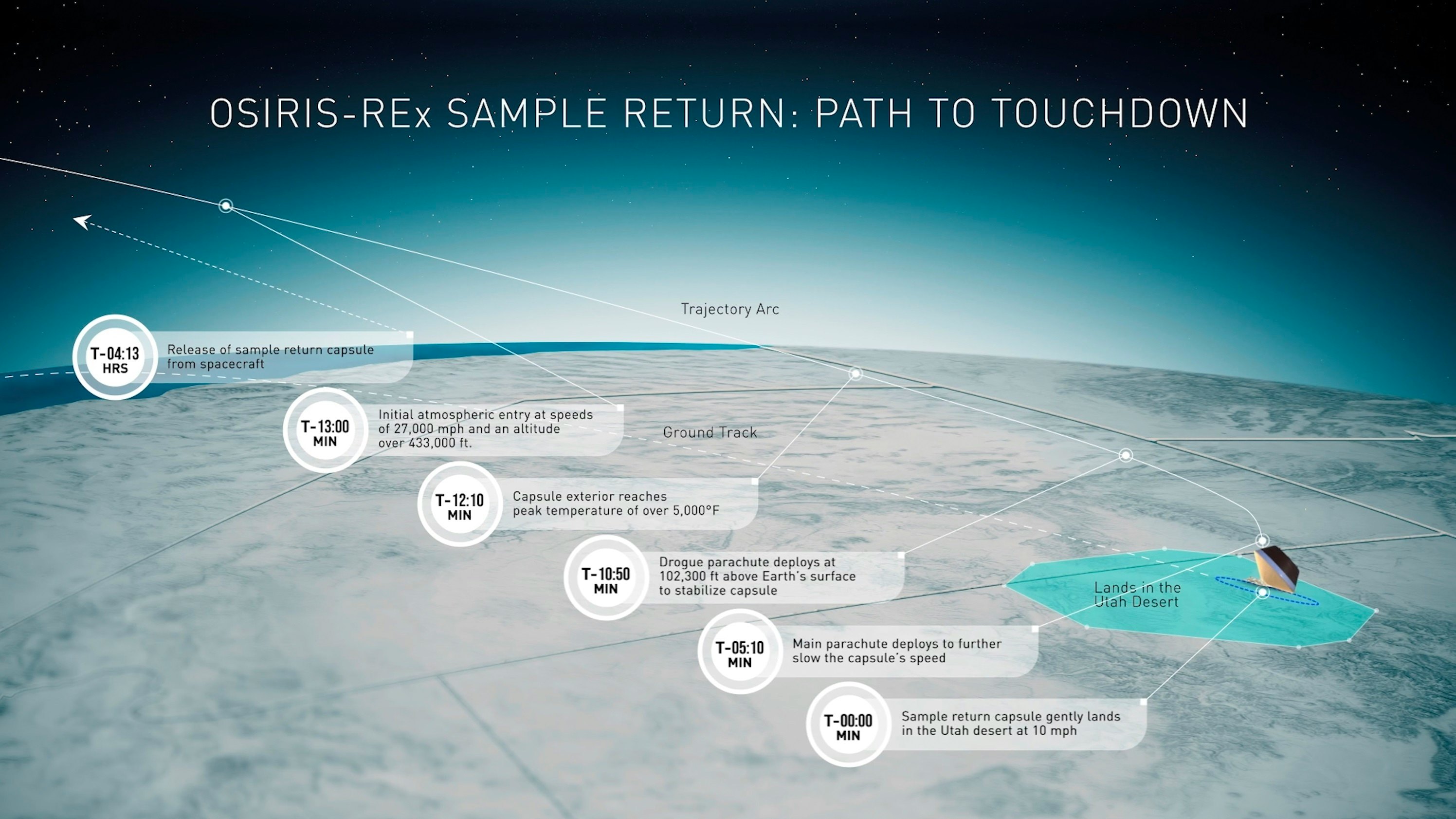
A handful of rock and dust from asteroid Bennu will be on its way to NASA’s Johnson Space Center today after landing in a remote stretch of Utah desert early Sunday morning, and the OSIRIS-REx spacecraft is on its way to another asteroid.
Stray bits of space rock fall into Earth’s atmosphere fairly often, sometimes offering spectacular displays for sky-gazers, but Sunday’s delivery arrived carefully packaged in a sealed canister, parachuting to a relatively gentle landing after being kicked out of a passing spaceship. Crews from NASA and Lockheed-Martin rushed the samples to a clean room, where they spent the night in “nitrogen purge.” The continuous flow of nitrogen is designed to protect the asteroid samples from contamination with molecules in the air here on Earth, which otherwise might skew the scientific analysis of Bennu’s chemical makeup.
A whole flock of instruments — some on the ground and some aboard aircraft stationed at a careful distance from the landing zone — tracked the OSIRIS-REx capsule’s descent Sunday morning. It took just minutes to locate and reach the capsule, and about another hour to package it up for its trip to the temporary clean room. From there, it’s bound for Johnson Space Center in Houston, Texas.
And where the long journey from Bennu and the wild ride to the ground end, the science can begin.
"While this may feel like the end of an incredible chapter, it’s truly just the beginning of another," Dante Lauretta, principal investigator for OSIRIS-REx at the University of Arizona, Tucson, said in a recent statement. "We now have the unprecedented opportunity to analyze these samples and delve deeper into the secrets of our solar system."
From Johnson, portions of the Bennu samples will soon be on their way to scientists around the world, who will study the material for clues about how water and organic chemicals arrived on Earth just in time to kickstart life as we know it. And OSIRIS-REx (or the spacecraft formerly known as ORISIS-REx, read on) is already long gone to its next errand, a 2029 rendezvous with another nearby asteroid called Apophis (a big favorite of both Egyptologists and Stargate: SG1 fans). The spacecraft even gets a spiffy new mission name: OSIRIS-APEX.

What is OSIRIS-REx? Where is Bennu, and why is it so important?
OSIRIS-REx, launched in 2016, is the first American mission to bring back samples of an asteroid. Japan has already done it twice, first bringing back a pinch of dust from the asteroid Itakawa in 2010 and then about a teaspoon of material from another asteroid, Ryugu, in 2020. But the eight ounces of dust and rock aboard OSIRIS-REx are the largest handful of asteroids anyone has managed to bring home so far — and they could be a treasure trove of information about the early Solar System and the delivery of water and other essential chemicals for life, to our planet.
Bennu is a carbon-rich asteroid, well stocked with organic compounds: Chemicals made of rings or chains of carbon atoms, usually also bound to hydrogen atoms. Organic compounds also often contain oxygen and nitrogen, along with other chemical elements. These chemicals are the building blocks of the building blocks (of the building blocks) of life.
During its mission, OSIRIS-REx also found evidence that there was once liquid water in one of the ancient asteroids that collided to form the pile of rocky debris that’s now Bennu. The science team is hoping to find traces of hydrothermal minerals, like the ones found around vents in the deep ocean floor here on Earth, dating back to the first ten million years of our Solar System’s history.
By studying the samples of Bennu that OSIRIS-REx brought home, scientists hope to learn more about how asteroids like Bennu may have brought their rich troves of water and organic compounds to Earth during a much earlier and more violent period in our Solar System’s history.
And Bennu itself is a product of that early violence; it’s what planetary scientists call a “rubble pile” asteroid; instead of a solid chunk of rock, Bennu is a floating pile of rocky chunks, loosely held together by their mutual gravity. Dimorphos, which was recently visited via the DART mission, is another rubble pile asteroid.
All of those things combine to make Bennu an interesting target for science, which is why OSIRIS-REx spent four years getting there and another two years bringing home souvenirs for hundreds of scientists around the world. The spacecraft launched in September 2016 (which NASA claims was actually just seven years ago, not several hundred, but we aren’t not convinced), gathered samples of rock and dust in 2020, and started for home in 2021.
Who Gets a Piece of the OSIRIS-REx Asteroid Samples?
NASA will keep about 70 percent of the 8.8 ounces of material OSIRIS-REx is dropping off; some will be available “on request” to scientists and schools around the world. Of the rest, about 25 percent will be split among the 233 scientists on the official OSIRIS-REx science team, who come from 38 institutions in several different countries. Tinier amounts will go to the Canadian Space Agency and the Japan Aerospace Exploration Agency – 4 percent and 0.5 percent of the total, respectively.
What’s About to Happen with OSIRIS-REx?
In the wee hours of the morning U.S. Mountain Daylight Time on Sunday, when OSIRIS-REx was still about 63,000 miles away from Earth and coming in hot, the spacecraft released the capsule full of asteroid bits. Four hours later, the sample capsule slammed into Earth’s atmosphere above the coast of California, moving at more than 27,000 miles per hour. A pair of parachutes popped out a few minutes later, and by the time the capsule settles to Earth at 8:52 A.M MDT, it was moving at a sedate 11 miles per hour.

The capsule’s target was a remote strip of Utah desert, 36 miles long and 8.5 miles wide, which belongs to the U.S. Department of Defense’s Utah Test and Training Range. Typically, the range plays host to weapons tests, military training exercises, and explosive ordnance disposal, but OSIRIS-REx wasn’t the range’s first space rodeo. Samples of comet dust from NASA’s Stardust mission landed here in 2006, and samples of cosmic wind particles from the Genesis mission had a bit of a rough landing here in 2004.
To hit that relatively small target, the whole process had to be choreographed almost perfectly. OSIRIS-REx fired its thrusters on September 10 to change its speed by just half a mile per hour — a tiny but crucial adjustment, without which the spaceship would just go whizzing past Earth too far away to drop off its package.
The spacecraft was still 4 million miles away at the time but closing fast. A week — and 2.2 million miles — later, on September 17, another tiny adjustment changed OSIRIS-REx’s speed (relative to Earth) by just 7 inches a minute. That nudged the spaceship’s landing site about eight miles east, aiming it right at its landing strip in Utah.







